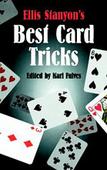Best Card Tricks
Ellis Stanyon

Appealing equally to amateurs and experts and all levels in between, Mr. Stanyon begins with clear and concise variations on simple methods of discovering and revealing a chosen card; he moves on to the more challenging and brilliantly conceived card tricks utilizing mathematical calculation, as well as card tricks via arrangement, confederates, card reading, and special prepared cards; he also covers forcing, stripped and cornered packs, the long and wide card; principles of sleight of hand, various methods of palming, changing, false shuffles and cuts; and finally, the book's finale details ornamental sleights and flourishes.
Ellis Stanyon's original text consists of step-by-step instructions for each and every trick discussed; interspersed throughout is Mr. Fulves' commentary and updates, accompanied by easy-to-follow diagrams. All these elements combine to enable you to successfully perform a host of mystifying manipulations that will baffle laypersons and professional magicians alike.
160 black and white illustrations. 336 pages, paperbound.
Reviews
(Top ▲)
Now, this book is composed of installments that Stanyon had originally published in Magic magazine, in 1911. As Karl Fulves astutely points out in the forward, this book provides a pure glimpse into the state of card magic at the turn of the 20th century. Indeed, there are effects, gaffs, and special decks in here that I'd never heard of before-but were quite popular at the time the work was published. I will get ONE complaint out of the way-and this, directed at Dover publishing. The cover of this book, has that 'god help me, not again' generic design-cards floating in space, standard type treatment, possibly designed with a computer program. It's also a paper back, which adds to the 'average, nothing special about this' quality. Considering WHEN this book originally came out-I wish to GOD that the art director at Dover had given this book's cover a bit more of a dignified, period looking treatment, than what they came up with. Looking at covers TELLS us something about whats inside-and I think that the material here warrants a cover that reflects the era when Stanyon was writing, as well as his efforts.
Considering what is available to magicians today-cds, dvds, online tutorials-a book like this might easily be overshadowed.
It was an attempt on Stanyon's part, to do what Robert Giobbi, Daryl, and other contemporary card masters have done: compile a definitive work on a subject that seems to be without end. Despite the miraculous technology of today-and how much easier it is to learn through watching videos-a book like this has relevence because of historical context. I just get the sense sometimes, that the younger people, and the ones coming up, are being raised on computers, videos-and books, well...I must be getting older, to still have more appreciation for them.
I had originally picked this up, for it's section on tricks. It was the most dissapointing aspect of the book, as these are the types of 'automatic effects' where court cards and aces, are laid out, mixed up-then 'magically assemble again. Kind of trick my Uncle Frank might have shown me. Nothing worth showing my 'I'm watching your every move, card guy' audiences. But then, these tricks were popular back then.
While Best Card Tricks covers slights, set ups, calculation tricks, passess, changes, flourishes-all that is covered in other works on cards- it's the sections on 'special cards' that I really appreciate. Talk about endurance, there are gaffed effects spelled out here, invented by Theodore Deland and Burling Hull, that are still being put to use today. Phil Goldstein, Bob Kohler, Gordon Bean and lord knows how many more contemporary card inventors, are capitalizing on these clever trick card devices. Most are possible to make yourself, a few require special printing. Along with this, pages on special decks, which are likewise, still popular today-and some, less known, that look quite ingenious and valuable, like 'the Master Mystery Forcing Pack'.
To me these are the areas of the book that I've spent most time in. The GOLD. As always-I find myself dealing with audience members who have never even seen ambitious card-nor have they seen any version of oil and water, or any sandwich effect. Heck-I run into countless people who've never even heard of the three card monte-or ANY monte effect. That said-effects from the past-despite their age, may indeed be utterly powerful and relevant to the performer, now.
I would and do suggest this book for the chapters on gaffs, and forcing decks-but would prefer the the 'other' master books on cards. There are more illustrations in them of a clearer quality-and they seem to have a greater quantity of information than this book. I should note that Karl Fulves does a good job here with commentary throughout-and offers more direct versions of some of the effects and sleights. Not a must have book, but a worthwhile curiosity.








